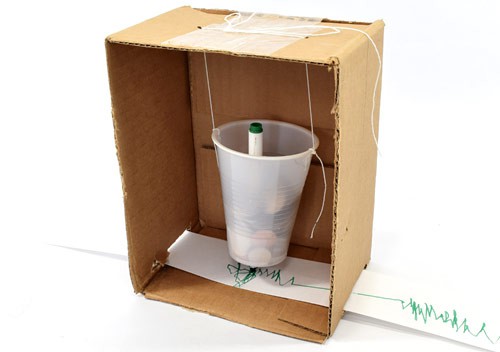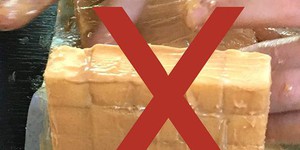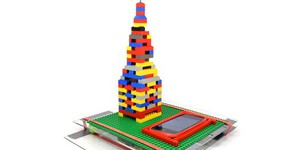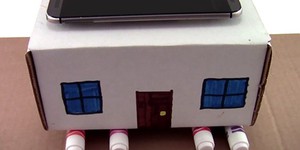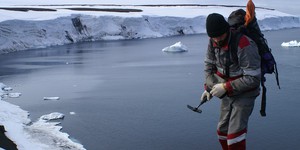Summary
Introduction
Scientists study earthquakes so we can understand them better and hopefully one day predict them so we can save thousands of lives. A seismograph is a tool scientists use to record earthquakes and measure their strength. In this activity you will build your own seismograph using simple materials.
Materials
- Medium-sized cardboard box
- Paper or plastic cup
- String
- Marker
- Scissors
- Paper, or a very long printed receipt from a store
- Tape
- Coins, marbles, small rocks, or other small, heavy objects to use as weights
- Another person to help
-
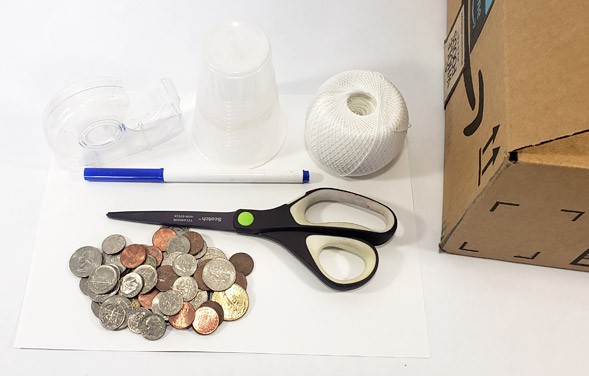 Image Credit: Ben Finio, Science Buddies / Science Buddies
Image Credit: Ben Finio, Science Buddies / Science Buddies
Instructions
- Cut the lid or flaps off the cardboard box. Stand the box up on one of the smaller sides.
- Poke two holes opposite each other near the rim of the cup.
- Tie a piece of string, slightly longer than the length of the box, to each hole.
- Poke two holes in the top of the box, making sure they are the same distance apart as the holes in the cup.
- Push the two pieces of string through the holes and tie them together on the top of the box, so the cup hangs down inside the box. The bottom of the cup should be about an inch above the bottom of the box.
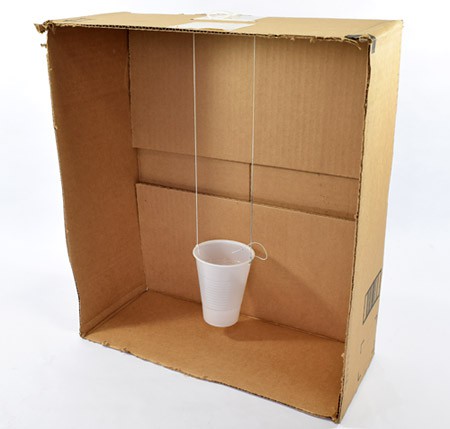 Image Credit: Ben Finio, Science Buddies / Science Buddies
Image Credit: Ben Finio, Science Buddies / Science Buddies
- Poke a hole in the center of the bottom of the cup. Remove the cap from the marker, and push the marker through the hole, so its tip just barely touches the bottom of the box.
- Fill the cup with coins or other small weights, making sure the marker stays vertical.
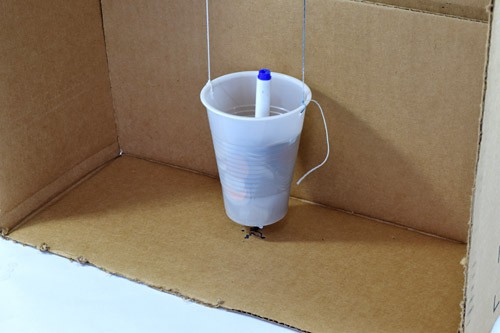 Image Credit: Ben Finio, Science Buddies / Science Buddies
Image Credit: Ben Finio, Science Buddies / Science Buddies
- Fold a piece of paper in half lengthwise, then fold it in half lengthwise again. Unfold the paper and cut along the folds to form four equal-sized strips. Tape the strips of paper together end to end, to form one long strip. If you have a long printed receipt, you can skip this step.
- Cut two slits on opposite sides of the cardboard box, as close as possible to the bottom edge. The slits should be wide enough to pass the paper strip through one side, across the middle of the box, and out the other side.
- Make sure the marker is centered on the paper strip. You might need to poke different holes in the top of the box and re-hang the cup if necessary.
 Image Credit: Ben Finio, Science Buddies / Science Buddies
Image Credit: Ben Finio, Science Buddies / Science Buddies
- Now you are finally ready to use your seismograph! Stabilize the box with your hands as your helper slowly starts to pull the paper strip through the box from one side to the other side.
- Now, shake the box back and forth (perpendicular to the paper strip, keeping the bottom of the box in contact with the table) as your helper continues to pull the paper strip through, doing their best to pull at a constant speed. How does the line on the paper strip change?
- Pause your shaking for a few seconds (as your helper continues to pull the paper), then try shaking the box harder.
- Pause for a few more seconds, then shake the box very gently.
- Pull the paper strip all the way out of the box and look at the line.Can you tell how hard the box was shaking based on the line? Can you tell when the box was not shaking at all?
What Happened?
When your helper pulls the paper through the box with no shaking, the marker should just draw a straight line on the paper. When you shake the box, it moves back and forth, and the paper moves along with it. Because of the heavy mass of the cup and the way it is suspended by strings, the cup does not move as much. This means that the paper moves back and forth under the (mostly) stationary marker, resulting in a squiggly line. The size of these squiggles (their amplitude) corresponds to how hard you shook the box, just like how the line drawn by a real seismograph corresponds to the strength of the earthquake. Read the Digging Deeper section to learn more about seismographs.
Digging Deeper
Earthquakes happen all the time, but most of them are so small that we can't feel them, and they do not cause any damage. However, large earthquakes can be quite catastrophic—destroying buildings and causing significant damage to property and loss of life. An earthquake's strength is measured on the Richter scale. The Richter scale goes from 1 to 10. Each increase of 1 on the Richter scale means the earthquake is actually 10 times more powerful (e.g. a 2.0 earthquake is 10 times stronger than a 1.0 earthquake, not twice as strong). As of 2019, the strongest earthquake ever recorded measured 9.5 on the Richter scale.
A seismograph is a machine used to measure the motion of the ground during an earthquake. Seismographs are very sensitive and can detect earthquakes that occurred very far away (along with other things that make the ground shake, like volcanic eruptions or large explosions) that might be too faint for humans to feel. Seismographs are made by hanging a heavy weight from a rigid frame connected to the ground. When the ground moves during an earthquake, the frame moves back and forth along with the ground. However, the heavy weight is not connected directly to the ground, and it wants to stay in place. The result is that the weight holds still, while the frame moves back and forth around it. The relative motion of the weight and frame can be turned into a recording called a seismogram. The seismogram can be analyzed later to find out when an earthquake happened and how strong it was. While modern seismographs record this motion as an electrical signal, older seismographs would use a pen to draw the signal directly on paper. In this activity you built your own old-fashioned seismograph that used a marker to record an "earthquake" on a paper strip.
Ask an Expert
For Further Exploration
- Does your seismograph work if you shake the box side-to-side or up and down? Can you design a seismograph that can record motion in multiple directions?
Related Resources
Project Ideas
Lesson Plans
- MS-ESS3-2. Analyze and interpret data on natural hazards to forecast future catastrophic events and inform the development of technologies to mitigate their effects.
- MS-ETS1-2. Evaluate competing design solutions using a systematic process to determine how well they meet the criteria and constraints of the problem.


